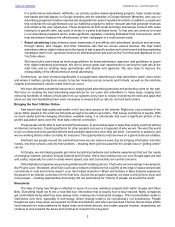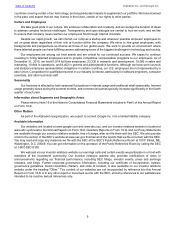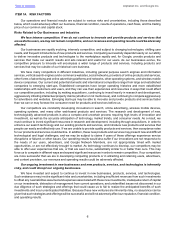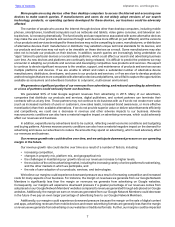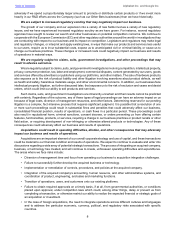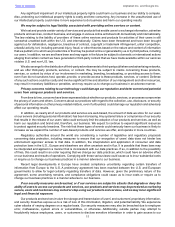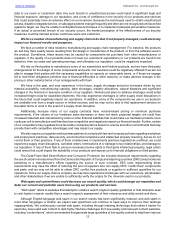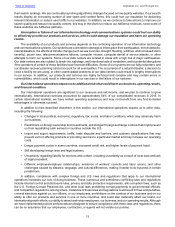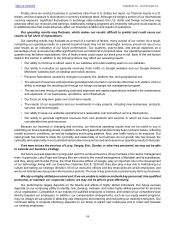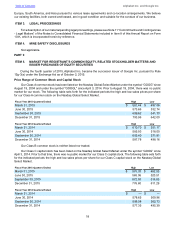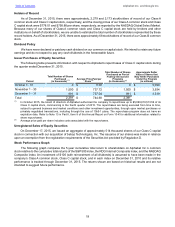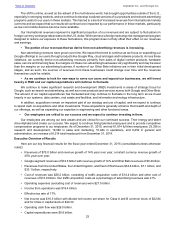Google 2015 Annual Report Download - page 17
Download and view the complete annual report
Please find page 17 of the 2015 Google annual report below. You can navigate through the pages in the report by either clicking on the pages listed below, or by using the keyword search tool below to find specific information within the annual report.
Table of Contents Alphabet Inc. and Google Inc.
13
their search rankings. We are continually launching algorithmic changes focused on low-quality websites. If our search
results display an increasing number of web spam and content farms, this could hurt our reputation for delivering
relevant information or reduce user traffic to our websites. In addition, as we continue to take actions to improve our
search quality and reduce low-quality content, this may in the short run reduce our AdSense revenues, since some of
these websites are AdSense partners.
Interruption or failure of our information technology and communications systems could hurt our ability
to effectively provide our products and services, which could damage our reputation and harm our operating
results.
The availability of our products and services depends on the continuing operation of our information technology
and communications systems. Our systems are vulnerable to damage or interruption from earthquakes, terrorist attacks,
natural disasters, the effects of climate change (such as sea level rise, drought, flooding, wildfires, and increased storm
severity), power loss, telecommunications failures, computer viruses, computer denial of service attacks, or other
attempts to harm our systems. Some of our data centers are located in areas with a high risk of major earthquakes.
Our data centers are also subject to break-ins, sabotage, and intentional acts of vandalism, and to potential disruptions
if the operators of certain of these facilities have financial difficulties. Some of our systems are not fully redundant, and
our disaster recovery planning cannot account for all eventualities. The occurrence of a natural disaster, a decision to
close a facility we are using, or other unanticipated problems at our data centers could result in lengthy interruptions
in our service. In addition, our products and services are highly technical and complex and may contain errors or
vulnerabilities, which could result in interruptions in our services or the failure of our systems.
Our international operations expose us to additional risks that could harm our business, operating results,
and financial condition.
Our international operations are significant to our revenues and net income, and we plan to continue to grow
internationally. International revenues accounted for approximately 54% of our consolidated revenues in 2015. In
certain international markets, we have limited operating experience and may not benefit from any first-to-market
advantages or otherwise succeed.
In addition to risks described elsewhere in this section, our international operations expose us to other risks,
including the following:
• Changes in local political, economic, regulatory, tax, social, and labor conditions, which may adversely harm
our business.
• Restrictions on foreign ownership and investments, and stringent foreign exchange controls that might prevent
us from repatriating cash earned in countries outside the U.S.
• Import and export requirements, tariffs, trade disputes and barriers, and customs classifications that may
prevent us from offering products or providing services to a particular market and may increase our operating
costs.
• Longer payment cycles in some countries, increased credit risk, and higher levels of payment fraud.
• Still developing foreign laws and legal systems.
• Uncertainty regarding liability for services and content, including uncertainty as a result of local laws and lack
of legal precedent.
• Different employee/employer relationships, existence of workers' councils and labor unions, and other
challenges caused by distance, language, and cultural differences, making it harder to do business in certain
jurisdictions.
In addition, compliance with complex foreign and U.S. laws and regulations that apply to our international
operations increases our cost of doing business. These numerous and sometimes conflicting laws and regulations
include internal control and disclosure rules, privacy and data protection requirements, anti-corruption laws, such as
the U.S. Foreign Corrupt Practices Act, and other local laws prohibiting corrupt payments to governmental officials,
and competition regulations, among others. Violations of these laws and regulations could result in fines and penalties,
criminal sanctions against us, our officers, or our employees, prohibitions on the conduct of our business and on our
ability to offer our products and services in one or more countries, and could also materially affect our brand, our
international growth efforts, our ability to attract and retain employees, our business, and our operating results. Although
we have implemented policies and procedures designed to ensure compliance with these laws and regulations, there
can be no assurance that our employees, contractors, or agents will not violate our policies.


